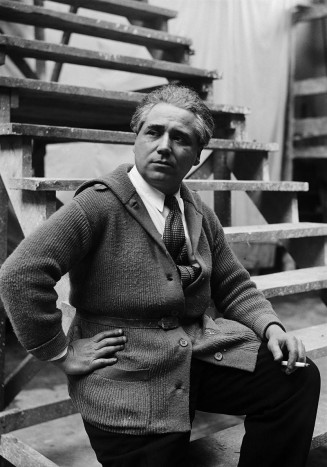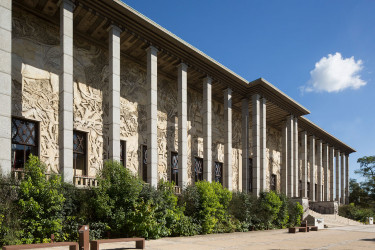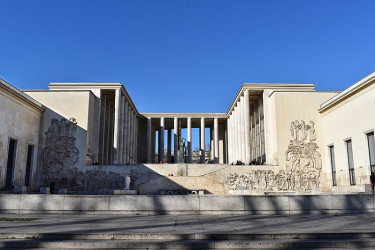Alfred Auguste Janniot
A sculptor recognised for his monumental decors in the inter-war period, Alfred Auguste Janniot was the author of the bas-relief that graces the entire facade of the Palais de la Porte Dorée across a surface of over 1,130 m², a real technical feat achieved in under two years.
Born in Paris in 1889, Alfred Janniot was drawn to drawing and modelling very early on, and in 1907 he entered the École Nationale Supérieure des Beaux-arts in the workshop of sculptor Jean-Antoine Injalbert (1845-1933). After his military service then mobilisation to the front, in 1919 he won the Prix de Rome for sculpture, at the same time as Raymond Delamarre (1890-1986), with two prize winners being named to catch up on the war years.
Initial works

Legende
Alfred Auguste Janniot
Credit
© Portrait de Therese Bonney, 1931, BHVP
From January 1920 to June 1924, Janniot stayed at the Villa Médicis, managed at the time by the sculptor Denys Puech (1854-1942), where among others he frequented the architects Jacques Carlu and Michel Roux-Spitz, painters Jean Despujols, Jean Dupas and Robert Poughéon. In Rome, he perfected his knowledge of antique art and Italian art, which influenced his initial works, such as Éros in 1922, a monumental work inspired by Roman bas-reliefs and Titian. Janniot then received an order for the 1925 International Exhibition of Decorative and Industrial Arts, a work destined for the entrance of the Hôtel du Collectionneur built for interior designer Ruhlmann. This was the Hommage à Jean Goujon, which confirmed the artist’s interest in the Renaissance, both Italian and French, and in Mannerism; from a stylistic viewpoint, the work comes close to a pictorial trend notably illustrated by Jean Dupas. As a result of this monumental group, Janniot won fame and formed lasting bonds with decorative artists like Ruhlmann.
The second major order that he received was for the monument to the dead in Nice, a project closely combining architecture and sculpture. The architect Roger Séassal, known at the Villa Médicis, suggested that he create two works for the facade of the monument, which he built directly on the cliff rock, on the ledge overlooking the sea. Janniot designed two hauts-reliefs, Horreurs de la guerre and Bienfaits de la paix, whose tight composition and powerful style are reminiscent of the reliefs Antoine Bourdelle created at the Théâtre des Champs-Élysées. As with his Roman works, Janniot worked very methodically: the design, the clay modelling on different scales, moulding in plaster then transferred to stone and finalised with a compass; for this final step, he was assisted by stonemasons, often Italian.
The large orders

Credit
© Pascal Lemaître, Palais de la Porte Dorée
By 1931, Alfred Janniot was a renowned artist who, in the following decade, received many orders for monumental reliefs in stone (the town hall in Puteaux, Châteauroux Chamber of Commerce, Bordeaux trade union centre), gilded bronze (Maison de France at the Rockfeller Center in New York City) or gilded stucco (banquet room for the Normandie ocean liner). Unlike the Palais des Colonies, where the work covers the entire wall like a “stone tapestry” (Albert Laprade), these reliefs fit inside a frame, like a painting.
In 1937, the decors designed for the forecourt of the Palais de Tokyo, on the occasion of the International Exposition of Art and Technology in Modern Life (Légende de la Terre and Légende de la Mer), only covered a part of the wall, following the shape of the building and not limited by a frame.

Legende
Palais de Tokyo
Credit
© Musée d'Art Moderne de la Ville de Paris
Alfred Janniot was also the creator of in-the-round statues made of bronze or stone; these were usually female or male nudes often inspired by mythological figures: Nymphe de Fontainebleau for the Ile-de-France ocean liner (1927) or Baigneuse for the Bibliothèque Nationale, redesigned by the architect Roux-Spitz (1938-1945).
The post-war period
In 1943, Janniot’s workshop was bombed, destroying many testimonials to his work. After the war, Janniot’s style, like that of the artists he frequented, went out of fashion; his activity then became focused on teaching monumental art at the École des Beaux-arts (1945-1959) and on orders he received through the French state’s 1% artistique programme (23 creations between 1941 and 1969), which often allowed him to revisit the bas-relief (École Nationale des Arts et Industries in Strasbourg, 1961).
In 1960, his entry into the Académie des Beaux-arts consecrated his official career. Janniot was also a designer and painter and made a few successful incursions into the field of tapestry. Representative of a generation still very much influenced by Italian art and borrowing from the repertoire of ancient mythology, Janniot mainly left his mark on the art of the first half of the 20th century through his monumental creations, demonstrating his capacity to adapt his style to the order. The bas-relief at the Palais de la Porte Dorée was undeniably his grand finale.



